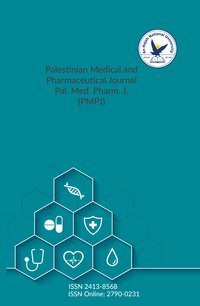Barriers to Breast Cancer Screening among Palestinian Women in Nablus Region, North-ern West Bank
Authors:
Article info
2019-08-26
2019-11-15
75 - 82
Keywords
- screening
- Breast Cancer
- Breast Self-Exam.
- Mammogram
Abstract
Breast cancer incidence in Palestinian Occupied Territories is less than western countries but it is the leading cause of cancer mortality among women. The Performance of breast can-cer screening leads to early detection and reduction of mortality. Hence it is important to un-derstand the barriers to breast cancer screening. A cross-sectional study that used a random sampling method recruited women from four women centers in Nablus district in West Bank including 127 women from Nablus city, 133 women from villages and 40 women from the refugee camps. A questionnaire was distributed to collect data on breast cancer screening per-formance attitudes including knowledge and barriers in addition to demographic variables. Data included information on breast self-examination (BSE), clinical breast examination (CBE) and mammogram. The results of the study indicated that a low number performed breast screening with 60.2% never did CBE and 74% never did a mammogram. Only 67.3% of women knew about (BSE), 47.6% women knew about (CBE) and 59.5% knew about a mammogram. Fear from many aspects related to disease and its consequences on an individ-ual, relationship to partner and family represented the major barrier. Also, the financial situa-tion was an obstacle, whereas religion as a barrier was present in 50% of participants. Time and financial were the main reasons behind the application of the study only in the Nablus district. The study concluded that there is a low performance of breast screening among Pal-estinian women that is associated mainly with fear of disease consequences.
AL-Tell, M., Natour, N., & Younes, D. (2020). Barriers to Breast Cancer Screening among Palestinian Women in Nablus Region, North-ern West Bank. Palestinian Medical and Pharmaceutical Journal, 5(2), 75–82. https://doi.org/10.59049/2790-0231.1061
[1]M. AL-Tell, N. Natour, and D. Younes, “Barriers to Breast Cancer Screening among Palestinian Women in Nablus Region, North-ern West Bank,” Palestinian Medical and Pharmaceutical Journal, vol. 5, no. 2, pp. 75–82, Dec. 2020, doi: 10.59049/2790-0231.1061.
AL-Tell, Mariam, et al. “Barriers to Breast Cancer Screening among Palestinian Women in Nablus Region, North-Ern West Bank.” Palestinian Medical and Pharmaceutical Journal, vol. 5, no. 2, Dec. 2020, pp. 75–82. Crossref, https://doi.org/10.59049/2790-0231.1061.
1.AL-Tell M, Natour N, Younes D. Barriers to Breast Cancer Screening among Palestinian Women in Nablus Region, North-ern West Bank. Palestinian Medical and Pharmaceutical Journal [Internet]. 2020 Dec;5(2):75–82. Available from: http://dx.doi.org/10.59049/2790-0231.1061
AL-Tell, Mariam, Nihal Natour, and Dina Younes. “Barriers to Breast Cancer Screening among Palestinian Women in Nablus Region, North-Ern West Bank.” Palestinian Medical and Pharmaceutical Journal 5, no. 2 (December 2020): 75–82. https://doi.org/10.59049/2790-0231.1061.
Barriers to Breast Cancer Screening among Palestinian Women in Nablus Region, North-ern West Bank
المؤلفون:
معلومات المقال
2019-08-26
2019-11-15
75 - 82
الكلمات الإفتتاحية
- screening
- Breast Cancer
- Breast Self-Exam.
- Mammogram
الملخص
Breast cancer incidence in Palestinian Occupied Territories is less than western countries but it is the leading cause of cancer mortality among women. The Performance of breast can-cer screening leads to early detection and reduction of mortality. Hence it is important to un-derstand the barriers to breast cancer screening. A cross-sectional study that used a random sampling method recruited women from four women centers in Nablus district in West Bank including 127 women from Nablus city, 133 women from villages and 40 women from the refugee camps. A questionnaire was distributed to collect data on breast cancer screening per-formance attitudes including knowledge and barriers in addition to demographic variables. Data included information on breast self-examination (BSE), clinical breast examination (CBE) and mammogram. The results of the study indicated that a low number performed breast screening with 60.2% never did CBE and 74% never did a mammogram. Only 67.3% of women knew about (BSE), 47.6% women knew about (CBE) and 59.5% knew about a mammogram. Fear from many aspects related to disease and its consequences on an individ-ual, relationship to partner and family represented the major barrier. Also, the financial situa-tion was an obstacle, whereas religion as a barrier was present in 50% of participants. Time and financial were the main reasons behind the application of the study only in the Nablus district. The study concluded that there is a low performance of breast screening among Pal-estinian women that is associated mainly with fear of disease consequences.
AL-Tell, M., Natour, N., & Younes, D. (2020). Barriers to Breast Cancer Screening among Palestinian Women in Nablus Region, North-ern West Bank. Palestinian Medical and Pharmaceutical Journal, 5(2), 75–82. https://doi.org/10.59049/2790-0231.1061
[1]M. AL-Tell, N. Natour, and D. Younes, “Barriers to Breast Cancer Screening among Palestinian Women in Nablus Region, North-ern West Bank,” Palestinian Medical and Pharmaceutical Journal, vol. 5, no. 2, pp. 75–82, Dec. 2020, doi: 10.59049/2790-0231.1061.
AL-Tell, Mariam, et al. “Barriers to Breast Cancer Screening among Palestinian Women in Nablus Region, North-Ern West Bank.” Palestinian Medical and Pharmaceutical Journal, vol. 5, no. 2, Dec. 2020, pp. 75–82. Crossref, https://doi.org/10.59049/2790-0231.1061.
1.AL-Tell M, Natour N, Younes D. Barriers to Breast Cancer Screening among Palestinian Women in Nablus Region, North-ern West Bank. Palestinian Medical and Pharmaceutical Journal [Internet]. 2020 Dec;5(2):75–82. Available from: http://dx.doi.org/10.59049/2790-0231.1061
AL-Tell, Mariam, Nihal Natour, and Dina Younes. “Barriers to Breast Cancer Screening among Palestinian Women in Nablus Region, North-Ern West Bank.” Palestinian Medical and Pharmaceutical Journal 5, no. 2 (December 2020): 75–82. https://doi.org/10.59049/2790-0231.1061.

Since 2022
Cite Score (Scopus): 0.8
Time to First Decision: 3 Days
Submission to Acceptance: 45 Days
Acceptance to Publication: 64 Days
Acceptance Rate: 17%
Why should you
Publish With Us?
An-Najah National University
Nablus, Palestine
Nablus, Palestine
- P.O. Box
- 7, 707
- Fax
- (970)(9)2345982
- Tel.
- (970)(9)2345560
- (970)(9)2345113/5/6/7-Ext. 2628
- [email protected]
- EIC
- Prof. Waleed Sweileh
The Palestinian Medical and Pharmaceutical Journal (Pal. Med. Pharm. J.) © 2024 by An-Najah University, Nablus, Palestine is licensed under CC BY-NC 4.0
News and Views
